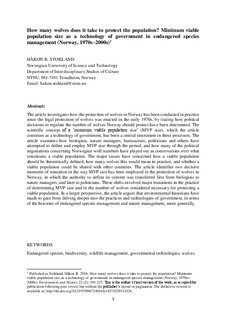| dc.contributor.author | Stokland, Håkon B. | |
| dc.date.accessioned | 2017-06-16T12:12:00Z | |
| dc.date.available | 2017-06-16T12:12:00Z | |
| dc.date.created | 2016-10-19T13:18:22Z | |
| dc.date.issued | 2016 | |
| dc.identifier.citation | Environment and History. 2016, (22), 191-227. | nb_NO |
| dc.identifier.issn | 0967-3407 | |
| dc.identifier.uri | http://hdl.handle.net/11250/2446288 | |
| dc.description.abstract | The article investigates how the protection of wolves in Norway has been conducted in practice since the legal protection of wolves was enacted in the early 1970s, by tracing how political decisions to regulate the number of wolves Norway should protect have been determined. The scientific concept of a 'minimum viable population size' (MVP size), which the article construes as a technology of government, has been a central instrument in these processes. The article examines how biologists, nature managers, bureaucrats, politicians and others have attempted to define and employ MVP size through the period, and how many of the political negotiations concerning Norwegian wolf numbers have played out as controversies over what constitutes a viable population. The major issues have concerned how a viable population should be theoretically defined, how many wolves this would mean in practice, and whether a viable population could be shared with other countries. The article identifies two decisive moments of transition in the way MVP size has been employed in the protection of wolves in Norway, in which the authority to define its content was transferred first from biologists to nature managers, and later to politicians. These shifts involved major transitions in the practice of determining MVP size and in the number of wolves considered necessary for protecting a viable population. In a larger perspective, the article argues that environmental historians have much to gain from delving deeper into the practices and technologies of government, in terms of the histories of endangered species management and nature management more generally. | nb_NO |
| dc.language.iso | eng | nb_NO |
| dc.publisher | White Horse Press | nb_NO |
| dc.title | How Many Wolves Does it Take to Protect the Population? Minimum Viable Population Size as a Technology of Government in Endangered Species Management (Norway, 1970s–2000s) | nb_NO |
| dc.type | Journal article | nb_NO |
| dc.type | Peer reviewed | nb_NO |
| dc.description.version | acceptedVersion | nb_NO |
| dc.source.pagenumber | 191-227 | nb_NO |
| dc.source.journal | Environment and History | nb_NO |
| dc.source.issue | 22 | nb_NO |
| dc.identifier.doi | 10.3197/096734016X14574329314326 | |
| dc.identifier.cristin | 1392920 | |
| dc.description.localcode | This is the author’s final version of the work, as accepted for publication following peer review but without the publisher’slayout or pagination. The definitive version is available at: http://dx.doi.org/10.3197/096734016X14574329314326 | nb_NO |
| cristin.unitcode | 194,62,40,0 | |
| cristin.unitname | Institutt for tverrfaglige kulturstudier | |
| cristin.ispublished | true | |
| cristin.fulltext | postprint | |
| cristin.qualitycode | 1 | |
